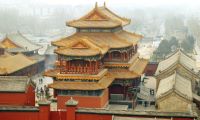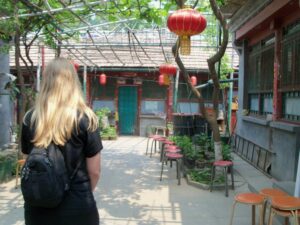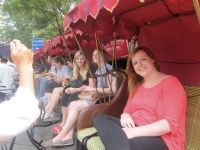On the road again
The students left yesterday in a burst of OMG activities. Before leaving for the airport, we:
1) Visited the Confucian temple and the Imperial College, both founded in the Ming period to train and honor the scholars who successfully passed the exams and became the ruling elite of China. Until the exams were abolished in 1905, the system of learning the Analects of Confucius was one of the surest ways to wealth and power. The top three scholars were honored by the emperor at the Forbidden City, and were allowed to march through the same middle gate as the emperor. All the scholars who passed the exams had their names inscribed on the steles, and I said that anyone whose name was on them would get an A in the class. Unfortunately for them, only my name and Professor Sikora’s were on the stele. At least that’s what I told them. Though the complex is not usually on the tourist main route, I thought it would be useful to see the “mother church” of Confucian education since we’d seen one of the “satellite” campuses in Hanoi, an indication of the power of Chinese civilization (I’d seen the equivalent in Seoul). As luck would have it, there was an International School graduation that day, so the college was set up to be a college that day. The Sage of Qufu (Confucius’ home town) would have been pleased.
Interestingly, the qualifying exams for universities today are just as competitive—and just as useful. When we went to Beijing University (the IWU of China), they boasted about the number of top student qualifiers the school had attracted from the Chinese provinces. And in Beijing several years ago, we had the president of Motorola speak to us. When she was done, she asked, “Any Questions?” She was Korean, and so I asked, “Did you graduate Seoul National or Yonsei University?” “Seoul National,” she replied, surprised. “But how did you know?” I knew because Confucius still lives in Asia.
2) The second must-do in that area, an area still marked by the dismount stones and other trappings of old Beijing, is the Yonghegang, the Lama  Temple. Originally the home of Yongzheng (who will play a role later in this narrative), it was converted by Qianlong into a Lama temple to honor his mother (a stout Buddhist) as a place for his loyal subjects from Tibet and Mongolia who followed the Lama version of Buddhism. It is the largest Buddhist temple in Beijing today, with a crowning hall housing a 23-meter standing Buddha made of one piece of wood (everything is the largest, biggest, tallest, etc., but you do have to watch the qualifiers). What I love most about it is that it incorporates the Tibetan/Mongolian gods, too, that are terrifying in their demonic postures, especially the blue demon that I think should be the DePaul mascot.
Temple. Originally the home of Yongzheng (who will play a role later in this narrative), it was converted by Qianlong into a Lama temple to honor his mother (a stout Buddhist) as a place for his loyal subjects from Tibet and Mongolia who followed the Lama version of Buddhism. It is the largest Buddhist temple in Beijing today, with a crowning hall housing a 23-meter standing Buddha made of one piece of wood (everything is the largest, biggest, tallest, etc., but you do have to watch the qualifiers). What I love most about it is that it incorporates the Tibetan/Mongolian gods, too, that are terrifying in their demonic postures, especially the blue demon that I think should be the DePaul mascot.
3) The third item (yes, we were busy—this was all before noon, and  probably seemed an eternity to those who sampled the nightlife as a
probably seemed an eternity to those who sampled the nightlife as a  personal farewell to the trip and to Beijing) was a tour of the hutong area around Houhai, one of the artificial lakes the imperials created for themselves north of the Forbidden City. The hutongs were the old-style homes with four square units surrounding a garden; it’s a Manchu word. Once the predominant housing in Beijing, they’ve been replaced by high rises, and maybe it’s not a bad thing. The units once had no electricity, water, or sanitary facilities, except what was common. Today, the area has gentrified and is now the playground of young Chinese, and the residence of older ones. We stopped
personal farewell to the trip and to Beijing) was a tour of the hutong area around Houhai, one of the artificial lakes the imperials created for themselves north of the Forbidden City. The hutongs were the old-style homes with four square units surrounding a garden; it’s a Manchu word. Once the predominant housing in Beijing, they’ve been replaced by high rises, and maybe it’s not a bad thing. The units once had no electricity, water, or sanitary facilities, except what was common. Today, the area has gentrified and is now the playground of young Chinese, and the residence of older ones. We stopped  at one for lunch, where a woman and her retired husband preside over an empty nest (children get married and want privacy) together with same-generation elders.
at one for lunch, where a woman and her retired husband preside over an empty nest (children get married and want privacy) together with same-generation elders.
Maybe I tired them out enough that they’ll sleep on the plane.